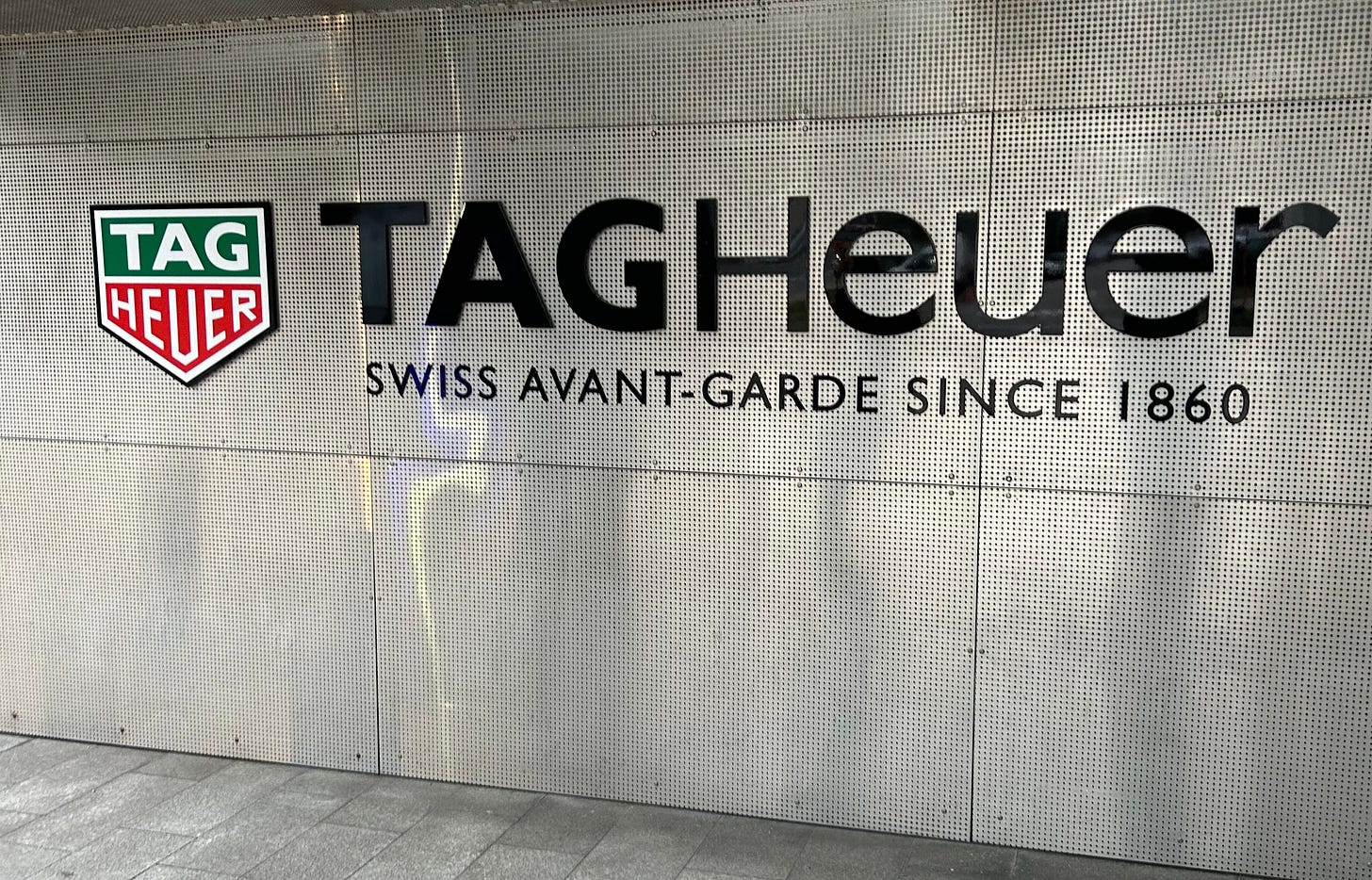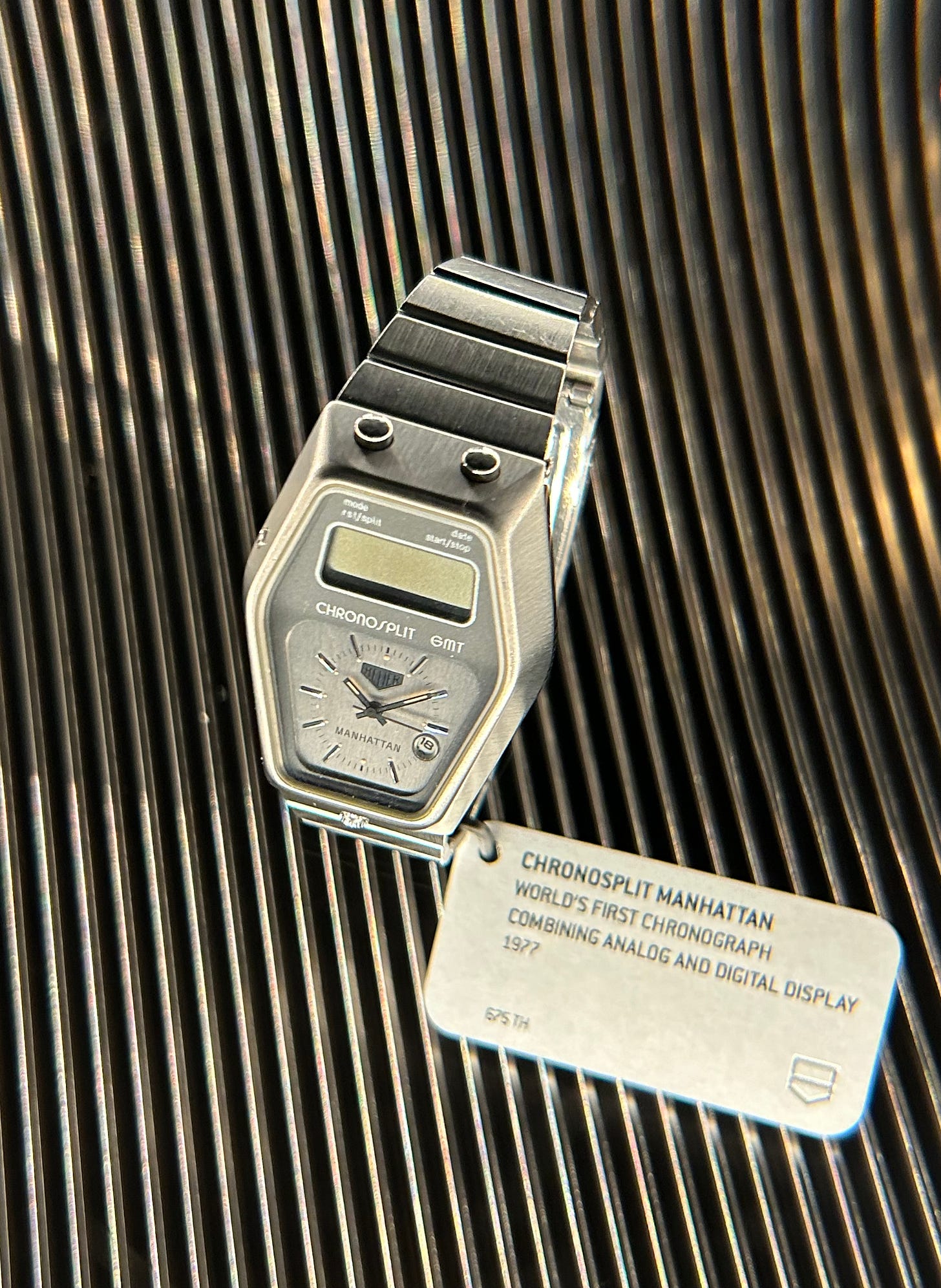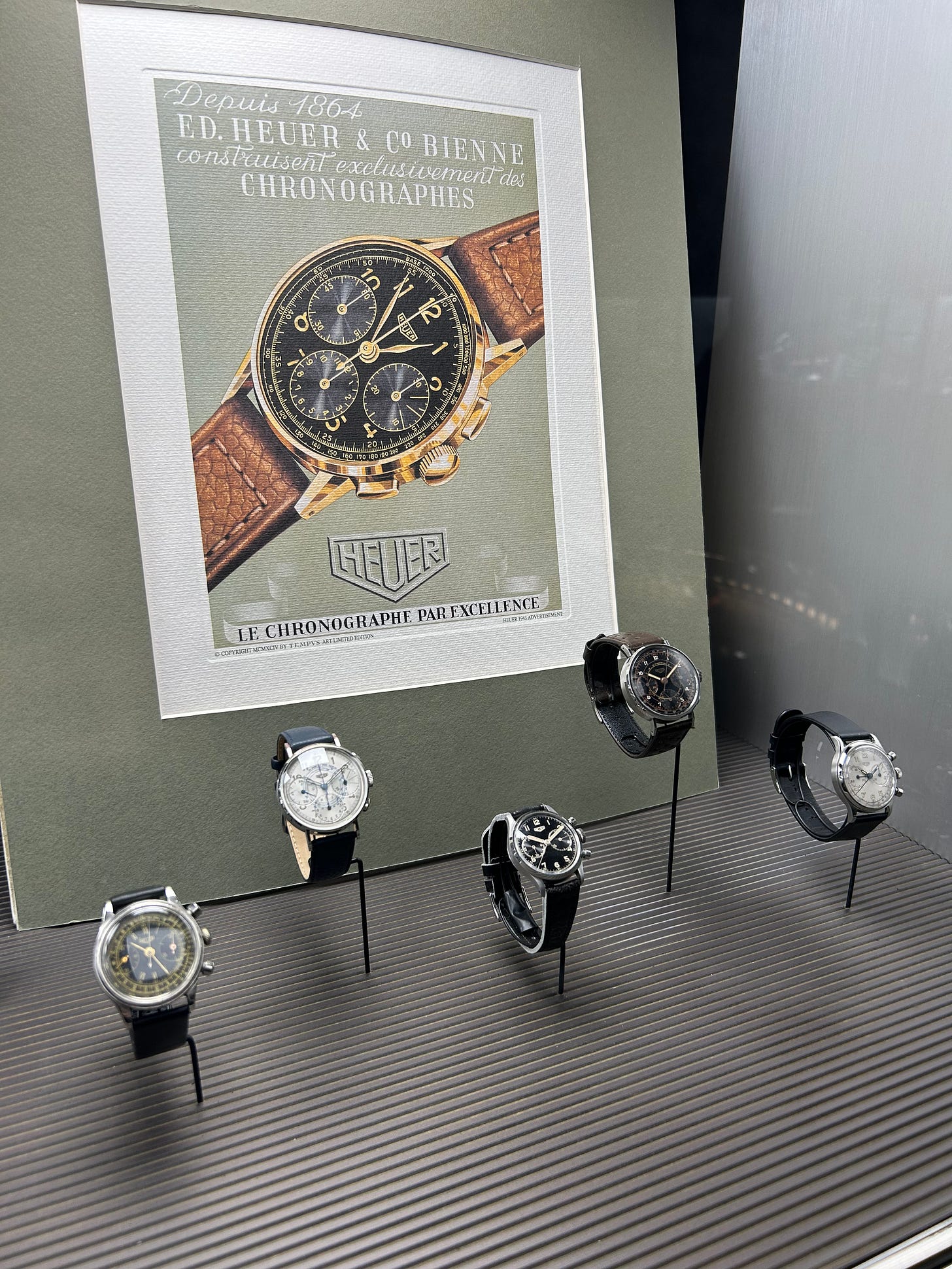Issue 133: The 2024 TAG Heuer Collector Summit
The most interesting - and unusual - things I saw at the home of Heuer
Hello and welcome back to The Fourth Wheel, the weekly watch newsletter that has been working hard on your end-of-year quiz. You lucky things! That will be with you next week, on Friday 20th December. This week, I am casting my mind back a month (impossible that it has only been a month, it feels like at least three) to my visit, as a guest of TAG Heuer, to its 2024 Collector Summit. You might have seen coverage of the event from the other two journalists who were there - Rich Fordon of Hodinkee and Johnny Davis of Esquire UK - but we saw and heard so much that there is almost no overlap whatsoever. I bring you weird and wonderful watches from forgotten eras of Heuer history, as well as a few words on the art and science of dial-making.
This issue is a bit of a deviation from the normal format, as a dispatch from Switzerland rather than a reaction to the week as seen from my desk in London. All the usual sections - recommended reading, scurrilous hearsay and so on - will return in the New Year.
PSA: there are a lot of images in this newsletter, which means you will have a much better experience reading it in your browser or the Substack app rather than in your emails. Tap the headline above and take it from there.
The Fourth Wheel is a reader-supported publication with no advertising, sponsorship or commercial partnerships to influence its content. It is made possible by the generous support of its readers: if you think watch journalism could do with a voice that exists outside of the usual media dynamic, please consider taking out a paid subscription. You can start with a free trial!
Here’s a little taste of what you might have missed recently:
Talking Watch Design With Fiona Kruger
Review: Omega Speedmaster FOIS 2024
Ask Me Anything + Audemars Piguet x KAWS
Harrods Tudor Leaked: Details Confirmed
Why Can’t London Host A World-Class Watch Event?
Here, Heuer, Here
TAG Heuer hasn’t held a Collector Summit for eight years. It held one in 2013, and one in 2016, but the brand has come a long way since then, and although a lot of the attendees were the same, this year’s event - orchestrated by TAG Heuer’s charismatic heritage director Nicholas Biebuyck - was presented as a fresh start. The intention is for the brand to host a summit every year from now on, serving as both a direct line of connection and communication with its most loyal vintage fans, and a way of eliciting feedback on the current direction of travel. It’s also a massive nerd-out with almost unrestricted access to the archives of a really beloved brand.
As I mentioned in my coverage of the GPHG awards, which came as part of the same trip, I was flown out and put up (and put up with) by TAG Heuer, all meals and what have you covered as part of the trip.
In a stark contrast to the normal Fourth Wheel modus operandi, I’m going to attempt to follow the principle of ‘show, don’t tell’ for once, because my main reaction to being allowed to poke around in the musuem and archives - yes, we got exceptional access as part of the visit - was to just say ‘oh my god I’ve never seen one of those before!’ over and over again. Editor’s note: this issue is as wordy as ever, just with more pictures :-) Some things in life are inevitable.
I did a slightly more journalistic interview with Nicholas which will see the light of day at a later date, although some of what he told me might permeate this email. The trip lasted two days in La Chaux de Fonds and saw us given a tour of the manufacture, a presentation of some 2025 watches, which I absolutely can’t talk about, a little information on a certain motorsport partnership which they absolutely can’t talk about (until January 1st 2025), a meeting with the design team, a tour of TAG Heuer’s (actually LVMH’s) dial factory ArteCad and more. I had the chance to pester Carole Kasapi, director of movements and haute horlogerie, with questions about everything from independent watchmakers to her Cartier days. I heard a metric ton of unrepeatable gossip, and set the watch world to rights with the likes of Jeff Stein, Eric Wind, George Bamford, Paul Maudsley and many others. In other words it was a bit of a dream ticket, and if you are thinking I might have a hard time retaining a degree of dispassionate, objective distance, you are absolutely right. Long-time readers will know I don’t approve of everything TAG Heuer does, but if there is one word I’d chose to characterise this experience, it would be ‘enthusiasm’, and that is infectious.

I’ve organised the images into two main sections - the museum and the archive that supports it - but some of them are ‘just because’ - like the above.
The Museum
TAG Heuer’s museum is, by their own admission, ripe for refurbishment - although it’s better than some I’ve seen. What’s in it is fantastic, but it is a dark room with lots of spot lighting and some very ‘avant garde’ large circular showcases, so I must apologise for my already average photography skills being handicapped even further.
Yes, we are starting in the early 2000s with this absolute beauty. If you are hoping for pictures of gorgeous Carreras, Autavias, Camaros and so on, I’m afraid you might be disappointed. There were many on display - so many that they almost started to feel commonplace, even though the assembled collectors had dug deep to bring their best and rarest examples. Some of the condition was insane. But you can see that stuff elsewhere - Rich Fordon in particular did a good job of spotlighting the classics - and everyone reading this, I expect, is pretty familiar with the Heuer Greatest Hits. They are superb watches but what really interests me is the chance to see something you’ve never seen before, or that people have forgotten because it’s not currently cool. This is very much in the latter category, as is the watch below. I am fascinated by the period in watch history - and it’s a moveable period - that brands have absolutely no interest in talking about, and right now that’s roughly 1999-2016, give or take, for most brands. This stuff hasn’t been around long enough to come back, but look at its sheer futurism! I don’t like the watches but I do like the idea of living in an era when brands made new stuff all the time. This cuff watch, the ‘diamond fiction1’ won a GPHG award in 2005. Can you imagine? It was priced at 100,000 euros and used tiny red LEDs beneath the diamonds to display the time - a simple digital watch decorated to the hilt. Obviously, the temptation is to scoff at it as a prime example of the era in which TAG Heuer lost sight of its heritage, but is it so far removed from the Carrera Plasma pieces?
This watch wasn’t designed by Tiger Woods, of course - not in any meaningful way at least. It was done by Ross Lovegrove, a professional product designer, a profile of whom I commissioned and published while I was at Mr Porter. There’s an enjoyable story about him trying very hard not to be given a free watch by TAG Heuer.
The same uncool, off-beat spirit flows through the below watch, a Heuer Manhattan from the late 1970s. At this time Heuer was not quite in a downward spiral (Jack Heuer would describe 1978 as an ‘annus horribilis’ in his autobiography) but it had been weathering tough times. The company rallied slightly in ‘77, and the Manhattan was in fact the world’s first ana-digi chronograph. Jack Heuer also tells a story about presenting one to Prince Philip at an equestrian event; the duke of Edinburgh was not impressed.
Unsurprisingly, there is a lot of space given over to TAG Heuer’s historic connections with motorsport in general and Formula 1 in particular. But there isn’t much room for the cult-collectible of the moment, the quartz, plastic and rubber F1 that’s as old as I am, and - if you can cast your minds back all the way to the start of this year - one of the big stories of 2024. I think when the museum is reorganised that just might change; read on for more colourful F1 fun in the archive section. I snapped this Christmassy number not realising how brilliantly seasonal it is.
I was also drawn to the pre-1960s chronographs; watches from the 1930s onwards, for the wrist and for the pocket, which are also not much spoken of these days. Something Nicholas and I discussed a little is that as a general rule, the Heuer collecting community is deeply passionate about a pretty narrow band of the company’s history - of course there are people who love it all, and people who love the less popular stuff because it’s less popular, and a few really early references were on display at the summit, but by and large if you’re into vintage Heuer you’re into the Carrera, the Autavia and the Monaco. It’s no different, really, at other brands, but this stuff is just so handsome and interesting I wanted to include it here.
Everything about this caption card is just excellent.
There are also some true oddities in the museum: I have picked out two of the most unusual that I saw. This first one isn’t unique, but I am a sucker for a roulette dial (as I am a bit of a sucker for actual roulette tables, but that’s another story).
This second one really is something I had never seen before: a mechanical (?) pregnancy calculator. There’s a joke here about wishing you’d had better timing, or it being the one time a watch fan doesn’t want any complications, but I’ll let you do your own.
Here are some other bits and pieces from the museum that caught my eye - a mix of older, newer, cherished and overlooked. The engine, by the way, is a McLaren F1 block, a 1.5l V6 developed by Porsche that Jeff Stein recently donated to the museum.
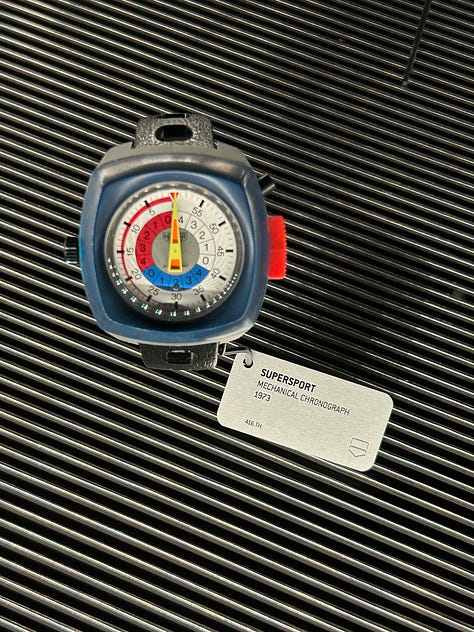



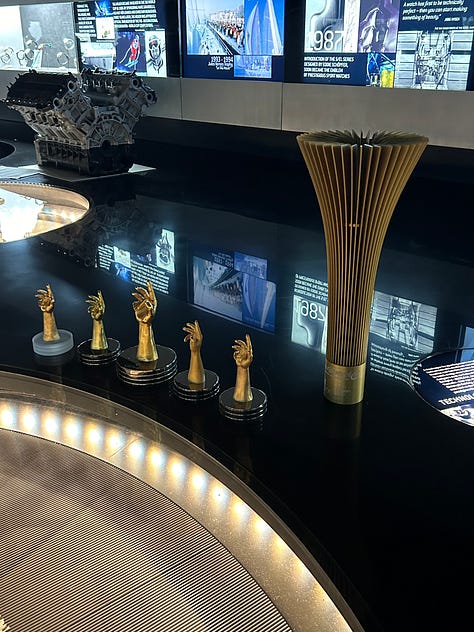

The Archive
This is where it gets really good. Behind the glossy presentation of the museum is a smaller back room where Biebuyck works; high-ceilinged and brightly lit, it holds the rest of the 3,000+ watches in TAG Heuer’s possession, as well as a trove of Heuer-branded memorabilia, timing equipment and god knows what else. Half a dozen wide, deep filing cabinets with shallow drawers lined two walls, each drawer home to dozens of watches from particular collections and eras. One collector described this as the ‘Turkish market’ section of the tour, because no matter the rarity or value, pretty much every watch is wrapped in protective plastic and tucked in like a sardine in a tin next to its peers. This is where everyone got really excited.
Keep reading with a 7-day free trial
Subscribe to The Fourth Wheel to keep reading this post and get 7 days of free access to the full post archives.



